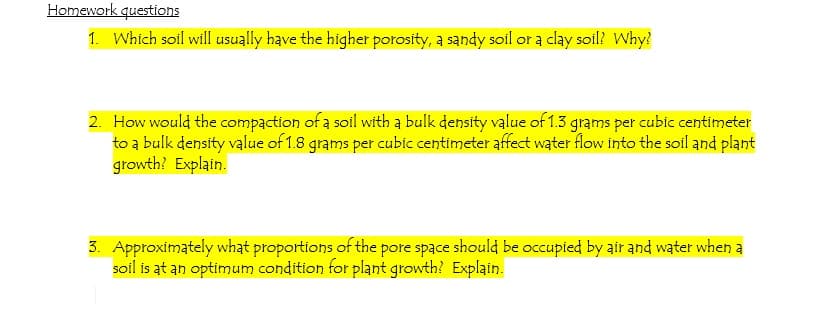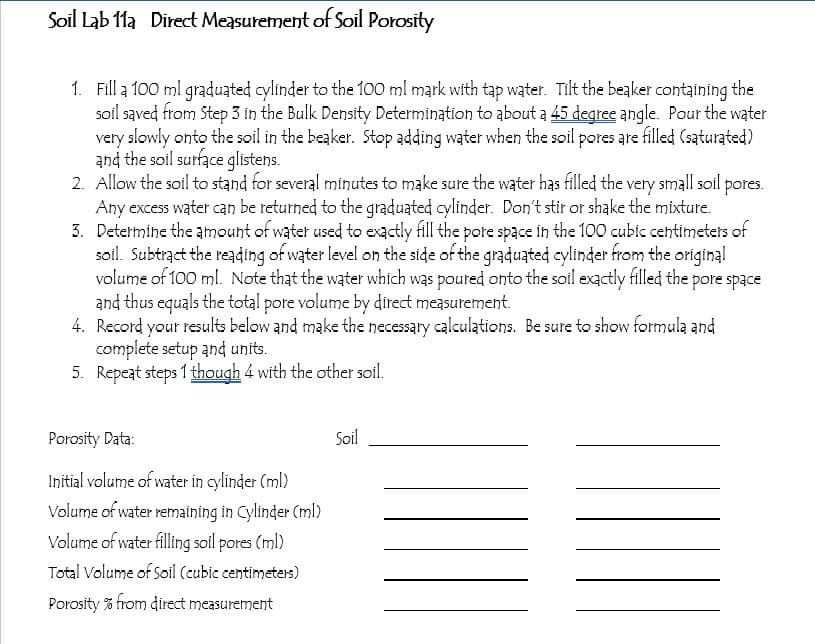Macroscale and Microscale Organic Experiments
7th Edition
ISBN:9781305577190
Author:Kenneth L. Williamson, Katherine M. Masters
Publisher:Kenneth L. Williamson, Katherine M. Masters
Chapter4: Recrystallization
Section: Chapter Questions
Problem 4Q
Related questions
Question

Transcribed Image Text:Homework questions
1. Which soil will usually have the higher porosity, a sandy soil or a clay soil? Why?
2. How would the compaction of a soil with a bulk density value of 1.3 grams per cubic centimeter
to a bulk density value of 1.8 grams per cubic centimeter affect water flow into the soil and plant
growth? Explain.
3. Approximately what proportions of the pore space should be occupied by air and water when a
soil is at an optimum condition for plant growth? Explain.

Transcribed Image Text:Soil Lab 11a Direct Measurement of Soil Porosity
1. Fill a 100 ml graduated cylinder to the 100 ml mark with tap water. Tilt the beaker containing the
soil sąved from Step 3 in the Bulk Density Determination to about a 45 degree angle. Pour the water
very slowly onto the soil in the beaker. Stop adding water when the soil pores are filled (saturated)
and the soil surface glistens.
2. Allow the soil to stand for several minutes to make sure the water has filled the very small soil pores.
Any excess water can be returned to the graduated cylinder. Don't stir or shake the mixture.
3. Determine the amouht of water used to exactly fill the pote space in the 100 cubic cehtimeters of
soil. Subtrąct the reading of water level on the side of the graduated cylinder from the original
volume of 100 ml. Note that the water which was poured onto the soil exactly filled the pore space
and thus equals the total pore volume by direct measurement.
4. Record your results below and make the necessary calculations. Be sure to show formula and
complete setup and units.
5. Repeat steps 1 though 4 with the other soil.
Porosity Data:
Soil
Initial volume of water in cylinder (ml)
Volume of water remaining in Cylinder (ml)
Volume of water filling soil pores (ml)
Total Volume of Soil (cubic centimeters)
Porosity % from direct measurement
Expert Solution
This question has been solved!
Explore an expertly crafted, step-by-step solution for a thorough understanding of key concepts.
This is a popular solution!
Trending now
This is a popular solution!
Step by step
Solved in 2 steps with 2 images

Knowledge Booster
Learn more about
Need a deep-dive on the concept behind this application? Look no further. Learn more about this topic, chemistry and related others by exploring similar questions and additional content below.Recommended textbooks for you

Macroscale and Microscale Organic Experiments
Chemistry
ISBN:
9781305577190
Author:
Kenneth L. Williamson, Katherine M. Masters
Publisher:
Brooks Cole

Principles of Instrumental Analysis
Chemistry
ISBN:
9781305577213
Author:
Douglas A. Skoog, F. James Holler, Stanley R. Crouch
Publisher:
Cengage Learning

Macroscale and Microscale Organic Experiments
Chemistry
ISBN:
9781305577190
Author:
Kenneth L. Williamson, Katherine M. Masters
Publisher:
Brooks Cole

Principles of Instrumental Analysis
Chemistry
ISBN:
9781305577213
Author:
Douglas A. Skoog, F. James Holler, Stanley R. Crouch
Publisher:
Cengage Learning